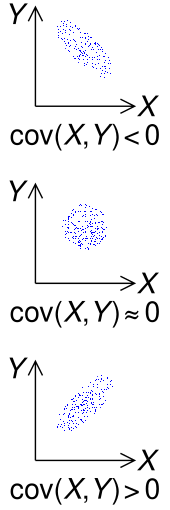
Back تغاير (إحصاء) Arabic Каварыяцыя Byelorussian সহভেদাঙ্ক Bengali/Bangla Covariància Catalan Kovariance Czech Kovarians Danish Kovarianz (Stochastik) German Kunvarianco Esperanto Covarianza Spanish Kobariantza Basque

Covariance in probability theory and statistics is a measure of the joint variability of two random variables.[1]
The sign of the covariance, therefore, shows the tendency in the linear relationship between the variables. If greater values of one variable mainly correspond with greater values of the other variable, and the same holds for lesser values (that is, the variables tend to show similar behavior), the covariance is positive.[2] In the opposite case, when greater values of one variable mainly correspond to lesser values of the other (that is, the variables tend to show opposite behavior), the covariance is negative. The magnitude of the covariance is the geometric mean of the variances that are in common for the two random variables. The correlation coefficient normalizes the covariance by dividing by the geometric mean of the total variances for the two random variables.
A distinction must be made between (1) the covariance of two random variables, which is a population parameter that can be seen as a property of the joint probability distribution, and (2) the sample covariance, which in addition to serving as a descriptor of the sample, also serves as an estimated value of the population parameter.
- ^ Rice, John (2007). Mathematical Statistics and Data Analysis. Brooks/Cole Cengage Learning. p. 138. ISBN 9780534399429.
- ^ Weisstein, Eric W. "Covariance". MathWorld.